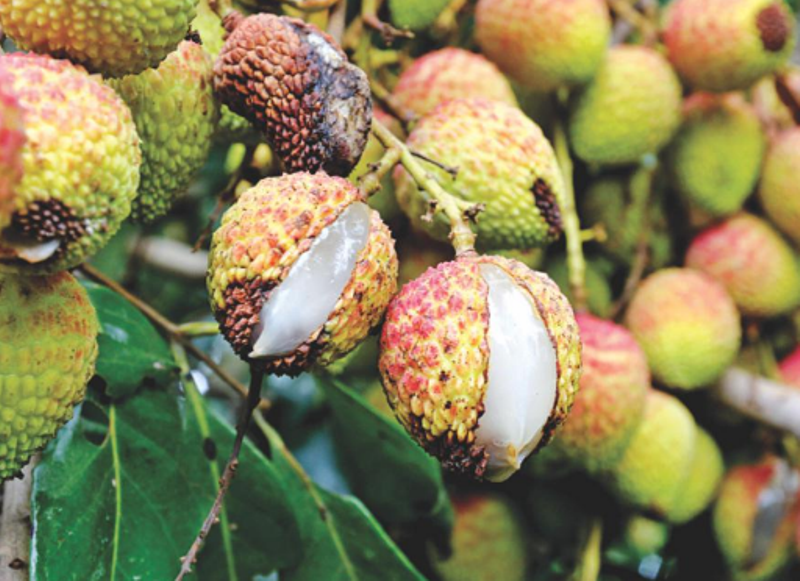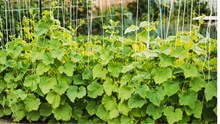
Introduction
The yield and quality of litchi fruits is affected by many physiological disorders like cracking of fruits, flower drop, fruit drop, sunburn, retarded fruit development, irregular bearing and black spot etc. Therefore, management of these physiological disorders is essential in obtaining potential yield and quality litchi fruits. This is also essential to know the physiological causes and symptoms accurately to handle these disorders for increased quality production. The occurrence and severity of these physiological disorders differ with region, season, cultivar and orchard management practices. These physiological disorders may be due to changes in ratio of endogenous hormone level or hormonal imbalance, nutrient deficiency in soil, inappropriate levels of water, sudden change in environmental conditions, varieties, poor management of litchi orchard etc.
Fruit Cracking
The fruit cracking in litchi is an important physiological disorder in litchi and reported in almost all the important litchi growing tracts of the India. The Loss due to this disorder reported as high as 5-70%. It affect the fruit quality, market value of fresh fruits, shelf life, and also susceptible to storage diseases. Healthy cracked fruits mainly used for processing purpose as cracked fresh fruit has less demand in fresh market very short storage and shelf life.
The fruit cracking may occur due to (a) Varietal characters (most of Indian varieties are susceptible to fruit cracking except Swarna Roopa), the cultivars with thick skins are less susceptible to cracking than those with thin skin (b) Soil water management, drought soon after fruit set as it affects development of fruit skin which becomes inelastic (c) Irrigation or heavy rain, or just an increase in relative humidity (d) Deficiencies of nutrients like calcium and boron in soil (e) Injury to skin by pest or mechanically during pericarp development phase may also lead to fruit cracking (f) Higher concentrations of abscisic acid (ABA) and lower level of Gibberellins found in the fruit pericarp, seed and aril of cracked fruits (g) Insects, hail, and the sun can damage the skin during cell expansion and induce cracking towards harvest (h) Hot wind during summer and over maturity of fruits. The cracked fruits worsen rapidly and thereafter suffer secondary infestation by disease causing organisms and insect-pests become non-marketable.
Management
-
Spray of plant growth regulators like 2,4-D and NAA at the concentrations of 20 ppm reduces cracking.
-
Application of calcium @ 2 m/l liquid formulations and Gibberellins @ 20 ppm, reduces the activity of cellulose and thereby reduced cracking as deficiency of calcium in soil and low endogenous level of gibberellins also causes cracking.
-
Spray of Borax or Boric acid @ 2g/l (to meet the boron requirement) at the initial stage of aril development with sufficient soil moisture in the root zone checks fruit cracking significantly.
-
Constant moisture and appropriate humidity are needed at the time of fruit maturity.
-
Irrigation at 30-40% depletion of available soil moisture is quite helpful in reducing cracking of fruits.
-
Installation of micro irrigation (drip as well as micro sprinkler) below the canopy area has been reported to be effective in reducing the fruit cracking.
-
Mulching has also been recommended in stabilizing the temperature and moisture level in root zone.
-
Planting wind break around the orchard provides protection from desiccating hot winds.
-
To save the cracking problem at maturity stage, fruit plants may be covered only on the top and permit free air flow into the sides. Control of cracking by covering the plants with net
-
Bagging: It is also a remedial operation to escape the sunlight from the plant surface because water is lost by transpiration though stomata.
-
Development of cracking resistant varieties as only one cultivar.
Fruit Drop
Even after prolific flowering and fruit set, a heavy flower and fruit drop is a major concern in litchi. The flower and fruit drop in litchi may be due to (a) failure of fertilization, embryo abortion, nutrition and hormonal imbalance especially auxin and (b) external biotic (fruit borer and heavy mite attack) and abiotic factors (westerly winds, low humidity and high temperature). The young bearing tree suffers fewer drops than the older trees. It has been reported that maximum fruit drop during the first fortnight after fruit set and continue up to maturity. The initial fruit set in litchi is very high but a very small proportion finally mature (2-18%). The endogenous level of auxin in developing fruit in litchi has also been taken into consideration for their fruit drops.
Management
-
Two foliar spray of 0.2% Boron for ensuring better pollen germination, fruit growth and development and for enhancement of fruit retention.
-
Two foliar applications of planofix @ 4 ml/5 litre water may be done at an interval of 15 days when fruits attain peanut size.
-
The application of plant growth regulators like NAA at 20-30 ppm, GA, at 20-25 ppm, 2,4-D at 10-20 ppm are effective in minimizing fruit drop when sprayed on panicles, before the flower opening.
-
The sprays of ZnSO4 @ 0.2% and synthetic auxins like 3,5,6-TPA can reduce the fruit drop.
-
Save honey bees, the main pollinators in litchi, to ensure better pollination and fertilization which increases the fruit set and retention. Avoid harmful spray of any chemicals at the blooming stage to save pollinators.
References
Singh VK, Pongener R and Purbey SK (2016). Physiological Disorders in Litchi and Their Effective Management.
https://www.google.co.in/url, tmnehs.gov.in
Author
Shailesh Kumar (Assistant Professor)
A K Singh (Professor&Head)
Department of Botany, plant Physiology & Biochemistry, CBS&H, RPCAU, Pusa, Samastipur, Bihar-848125,Email- shailesh_agri@yahoo.com
Sweta Mishra (Associate Professor, COB, SVPUAT, Meerut, UP-250110)












Share your comments